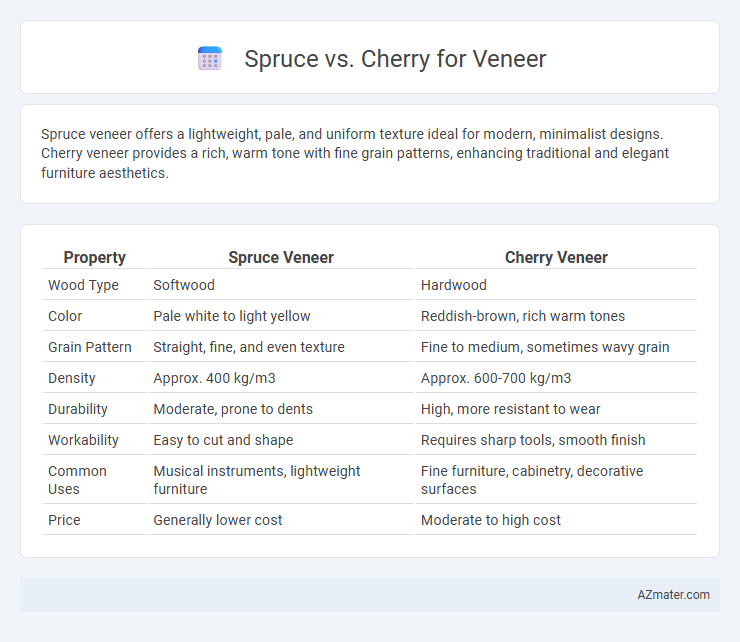Spruce veneer offers a lightweight, pale, and uniform texture ideal for modern, minimalist designs. Cherry veneer provides a rich, warm tone with fine grain patterns, enhancing traditional and elegant furniture aesthetics.
Table of Comparison
| Property | Spruce Veneer | Cherry Veneer |
|---|---|---|
| Wood Type | Softwood | Hardwood |
| Color | Pale white to light yellow | Reddish-brown, rich warm tones |
| Grain Pattern | Straight, fine, and even texture | Fine to medium, sometimes wavy grain |
| Density | Approx. 400 kg/m3 | Approx. 600-700 kg/m3 |
| Durability | Moderate, prone to dents | High, more resistant to wear |
| Workability | Easy to cut and shape | Requires sharp tools, smooth finish |
| Common Uses | Musical instruments, lightweight furniture | Fine furniture, cabinetry, decorative surfaces |
| Price | Generally lower cost | Moderate to high cost |
Introduction to Spruce and Cherry Veneer
Spruce veneer is prized for its pale color, fine grain, and lightweight yet durable nature, making it a popular choice for acoustic instruments and high-end furniture. Cherry veneer offers a rich, warm reddish-brown hue with a smooth texture that darkens gracefully over time, creating a sophisticated and elegant appearance in cabinetry and decorative paneling. Both veneers provide unique aesthetic qualities and structural properties tailored to different design preferences and applications.
Botanical Origins and Wood Characteristics
Spruce veneer originates from the Picea genus, known for its light color, straight grain, and soft texture, making it ideal for acoustic properties and lightweight applications. Cherry veneer comes from the Prunus genus, featuring a rich reddish hue, smooth grain, and medium hardness, which enhances durability and aesthetic warmth. Both woods offer distinct botanical traits and textures that influence their suitability for specific veneer uses in furniture and cabinetry.
Appearance and Color Comparison
Spruce veneer features a light, creamy white to pale yellow tone with subtle, straight grain patterns that create a clean and airy aesthetic, making it ideal for modern and minimalist designs. Cherry veneer exhibits warm, rich reddish-brown hues that deepen with age, complemented by fine, smooth grain lines adding elegance and sophistication to furniture and cabinetry. The color stability and distinctive reddish undertones of cherry contrast with spruce's lighter, more neutral palette, providing diverse options based on desired visual warmth and style.
Grain Patterns and Texture
Spruce veneer features a straight, uniform grain with a fine, even texture that creates a smooth and consistent surface, ideal for modern and minimalist designs. Cherry veneer displays a more pronounced grain pattern with subtle variations and a fine, satiny texture that deepens in color and character over time. Both woods offer unique aesthetic qualities, with spruce providing clarity and lightness, while cherry adds warmth and rich visual interest.
Workability and Machinability
Spruce veneer offers excellent workability due to its straight grain and softness, making it easy to cut and shape with minimal wear on tools. Cherry veneer, while slightly harder, provides superior machinability with smooth sanding and a fine finish, ideal for detailed woodworking projects. Both veneers respond well to adhesives and finishes, but spruce is preferred for quick, precise cuts, whereas cherry excels in molds and intricate patterns.
Durability and Longevity
Spruce veneer offers moderate durability with a softer texture prone to denting and wear over time, making it less ideal for high-traffic applications. Cherry veneer boasts superior longevity due to its dense grain structure and natural resistance to impact, scratches, and aging. For furniture or cabinetry requiring long-lasting veneer solutions, cherry provides enhanced durability and enduring aesthetic appeal compared to spruce.
Cost and Availability
Spruce veneer is generally more affordable and widely available due to the abundance of spruce trees and faster growth rates, making it a cost-effective choice for large projects. Cherry veneer tends to be more expensive and less readily available because cherry trees grow slower and are harvested less frequently, resulting in a premium cost. Buyers seeking a balance between budget and aesthetics often select spruce, while those prioritizing rich color and grain patterns prefer the higher-priced cherry veneer.
Environmental Impact and Sustainability
Spruce veneer is generally considered more sustainable due to its faster growth rate and lower environmental footprint compared to cherry, which grows slower and requires more intensive forest management. The carbon sequestration potential of spruce forests is higher because of their rapid regeneration, making spruce a greener choice. Cherry veneer, while prized for its rich color and durability, often comes from older, slower-growing trees, raising concerns about deforestation and habitat disruption.
Ideal Applications for Spruce and Cherry Veneer
Spruce veneer is ideal for applications requiring lightweight, flexible wood with a tight grain pattern, commonly used in musical instruments, lightweight furniture, and architectural paneling where acoustic properties are important. Cherry veneer excels in fine furniture, cabinetry, and decorative surfaces due to its rich color, smooth texture, and durability, making it suitable for high-end interiors and detailed woodworking projects. Both veneers offer unique advantages: Spruce provides resonance and flexibility, while Cherry delivers elegance and strength in design applications.
Summary: Choosing Between Spruce and Cherry for Veneer
Spruce veneer offers a lighter color with a straight, uniform grain, making it ideal for modern, minimalist designs and applications requiring a bright, clean appearance. Cherry veneer features a rich, reddish-brown hue that deepens with age and possesses a fine, smooth grain, preferred for traditional and elegant furniture pieces. Selecting between spruce and cherry veneer depends on the desired aesthetic, wood grain preference, and intended durability for the project.

Infographic: Spruce vs Cherry for Veneer
 azmater.com
azmater.com